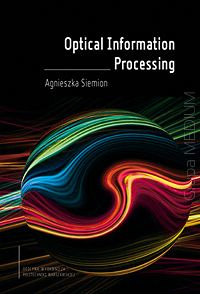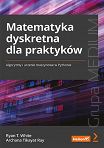Optical Information Processing
- Dodaj recenzję:
- Kod: 4326
- Producent: Oficyna Wydawnicza Politechniki Warszawskiej
- Autor: Agnieszka Siemion
-
-
- szt.
- Cena netto: 30,48 zł 32,00 zł
Optical Information Processing
rok wydania: 2019
ISBN: 978-83-7814-894-4
ilość stron: 64
oprawa: miękka
Opis
This elaboration describes the exemplary material needed for Optical Information Processing laboratory exercises – the course at the Faculty of Physics at Warsaw University of Technology. The topics were chosen as complementary for a better understanding of the lecture and workshops. There are 7 laboratory exercises allowing to acquire practical knowledge about holography, optical setups and its numerical counterparts. All these problems are related to the optical information processing and performing such laboratory exercises can help to understand the processing and application of optical information.
These experiments can be carried out during specializations connected to optics and photonics as advanced laboratory exercises.
The first two exercises are related to interferometry and holography which can be used for example in detailed analysis of surface shape or deformations of objects. Holographic inspection of elements is a very precise method of measurement allowing to visualize micro changes or even internal defects.
Then, the basics of operation in angular spectrum space is presented by performing spatial filtering, observing correlation and recording Fourier holograms. Deep understanding of processing images in frequency domain helps to carry out both optical setups and numerical algorithms.
The majority of optical setups carried out on laboratories will be modelled numerically during the 6th laboratory. Numerical processing of optical signals is very important in practicing the understanding of what is the difference between discrete and continuous signals processing. The sampling theorem plays a great role in proper designing of optical signals.
The last laboratory part corresponds to designing and exposing holograms that can be reconstructed in white light. The whole knowledge gathered during these classes should help with understanding the idea of optical processing of signals.
Spis treści
Introduction / 7
Laboratory 1
DOUBLE-EXPOSURE FRESNEL HOLOGRAM / 9
One-exposure Fresnel hologram / 9
Double-exposure Fresnel hologram / 11
Laboratory 2
EXAMINATION OF LENS QUALITY / 18
Ronchi interferometer (lateral shear interferometry) / 18
Shack-Hartmann test / 20
Mach-Zehnder interferometer / 22
Twyman-Green interferometer / 24
Laboratory 3
SPATIAL FILTERING – IMAGE PROCESSING IN FOURIER DOMAIN / 26
Optical setups and their Fourier planes / 31
Filtration of spatial frequencies / 34
Spatial filtering – theta modulation / 37
Laboratory 4
CORRELATION AND FOURIER HOLOGRAM / 39
Fourier hologram / 39
Lensless Fourier hologram (Quasi-Fourier hologram) / 43
Van der Lugt correlator / 44
Laboratory 5
PHASE CONJUGATION IMAGING (TIME REVERSAL IMAGING) / 47
Phase conjugation / 47
Recording Fresnel hologram and its reconstruction with the beam conjugated to the reference beam / 49
Laboratory 6
NUMERICAL REALIZATION OF OPTICAL SETUPS / 52
Discrete Fourier transform / 52
Fast Fourier transform / 53
Numerical propagation / 54
Laboratory 7
VOLUME HOLOGRAM / 58
Bragg diffraction / 59
Reconstruction in white light / 59
Bibliography / 63


